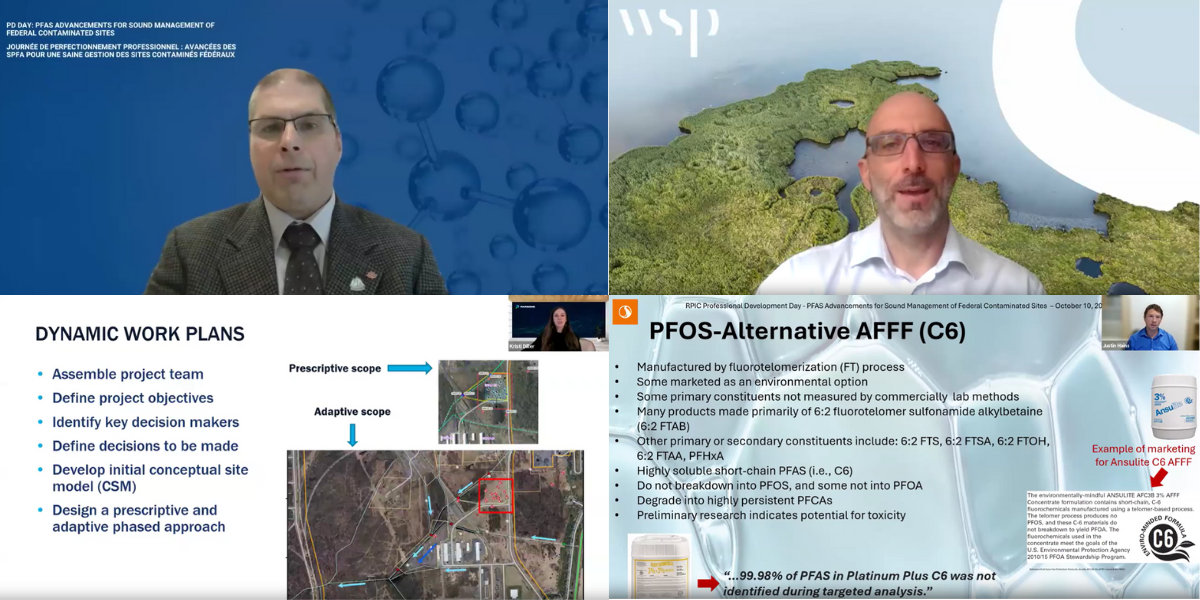2024 PD Day - PFAS Advancements for Sound Management of Federal Contaminated Sites

The Professional Development Day on October 10, 2024, covered PFAS management in federal contaminated sites. Sessions addressed site characterization, analytical developments, regulatory trends, remedial objectives, technology selection, and liability management for site managers.
Download Program (PDF)Speakers
Kristi Diller
Project Geologist and PFAS Investigation Subject Matter Expert, Parsons
Stefano Marconetto
Sr. Principal and Emerging Contaminants Practice Lead, WSP
Stephen Sauveur
Regional Service Line Leader. Environmental Services, Atlantic, Defence Construction Canada
Sessions Description
Dynamic investigation approaches allow for flexibility during site characterization to manage decision uncertainty. The nature and extent of PFAS compounds are directly related to their release mechanisms (e.g., spraying of firefighting foam, aerial dispersion from an industrial facility, sewer discharges, or seepage from a landfill) that interact with the physical elements of the conceptual site model (CSM) (e.g., land use, topography, hydrology, stratigraphy, migration mechanisms, and transport pathways). Unique properties of PFAS further influence their fate and distribution. Consequently, insight and clarity are achieved by combining a robust three-dimensional CSM with knowledge of PFAS release and transport characteristics. The CSM …
Speakers
Justin Hains
Project Manager, Team Lead, Stantec Consulting Ltd.
Sessions Description
This presentation originates from a recent case study involving an accidental release of a sprinkler system in an airplane hangar, which discharged aqueous film-forming foam (AFFF) containing per- and polyfluoroalkyl substances (PFAS). The AFFF used was Ansulite 3%, a product among several other next generation AFFFs that came to market labelled as an environmentally friendly alternative to PFOS-based AFFF. It is understood that C6-based AFFF have consisted mostly of some variation with primarily 6:2 fluorotelomer betaine (6:2 FTAB), and secondarily 6:2 fluorotelomer sulfonate (6:2 FTS).In recent years these PFOS-alternative AFFF have also started being phased out by some agencies around …
Speakers
Angus Calderhead
Senior Hydrogeologist, Environnement and Climate Change Canada (ECCC)
Christine Levicki
Environmental Specialist, Health Canada
Maria Petrou
Coordinator, Contaminated Sites, Environment and Climate Change Canada
William Martin
Physical Science Specialist, Environment and Climate Change Canada (ECCC)
Sessions Description
The FCSAP Expert Support Departments (ESDs) are working together to create an Interim FCSAP PFAS Guidance to be used to assess federal PFAS contaminated sites. An overview of what this document will contain will be shared. During this session, ESDs are interested in receiving feedback from custodians and/or consultants managing PFAS sites regarding their needs and current gaps. This feedback will be used to further develop the content of the guidance document in progress. A brief overview of environmental criteria will also be presented during this session followed by Q&As.
Speakers
Andrew White
Business Development – Emerging Markets, Bureau Veritas
Bharat Chandramouli
DIrector, Products, SGS
Egemen Aydin
Senior Scientific Advisor, AGAT Labs
Tammy Chartrand
National PFAS Program Lead, ALS
Sessions Description
This panel features four presentations by analytical laboratories followed by Q&As. The presentations will cover the entire process from sampling preparation to analytical data review including: best practices for PFAS sampling, how to select from multiple analytical methods for various environmental media including targeted and non-targeted analyses, as well as QA/QC and interpretation of laboratory data.
Speakers
Mary Ellen Starodub
National Risk Assessment Lead, AECOM Canada
Sessions Description
Key characteristics of PFAS when developing a problem formulation for risk assessment and the inherent uncertainties involved, under the current framework for risk management of contaminated sites in Canada, will be examined. Risk assessment of PFAS will be discussed in the context of Canada’s State of PFAS report and Risk Management Plan, and the available guidance and tools by Health Canada (including HC’s recent drinking water objective for PFAS as a class of contaminants), Environment and Climate Change Canada (ECCC), the Canadian Council of Ministers of the Environment (CCME), and other jurisdictions. A comparison will be presented of risk assessment …
Speakers
Jennifer Benaman
Principal, Anchor QEA
Sessions Description
Jennifer Benaman ([email protected]) (Anchor QEA, Saratoga Springs, NY, USA), John Connolly, David Glaser, Beth Lamoureux, and Wen Ku (Anchor QEA, Woodcliff Lake, NJ, USA), Sarah LaRoe (Anchor QEA, Saratoga Springs, NY, USA), Dan Opdyke (Anchor QEA, LLC, Austin, TX, USA), and Deirdre Reidy (Anchor QEA, Syracuse, NY, USA).Background/Objectives. Regulatory attention continues to grow around per- and polyfluoroalkyl substances (PFAS). Initially, much focus was on drinking water because that was recognized as the largest and most readily addressable human health exposure pathway. But, as research has expanded and more sites with drinking water issues are successfully addressed through treatment and remediation, …
Speakers
Andrew Thalheimer
Partner, Dillon Consulting
Ben Sweet
Director of Environmental Technologies, QM Environmental
Bill Malyk
Senior Principal Engineer, WSP Canada Inc.
Bruce Tunnicliffe
President, VEI Contracting Inc.
Korene Torney
Senior Project Manager, SLR Consulting (Canada) Ltd.
Rick McGregor
President, InSitu Remediation Services Ltd
Stefano Marconetto
Sr. Principal and Emerging Contaminants Practice Lead, WSP
Stephen Sauveur
Regional Service Line Leader. Environmental Services, Atlantic, Defence Construction Canada
Sessions Description
By moving through the main aspects of the remediation / treatment lifecycle, this panel will have interactive discussions on setting remedial objectives, technology evaluation and selection for different media, technical specifications, execution, post-remediation monitoring, residual liability management and more.
